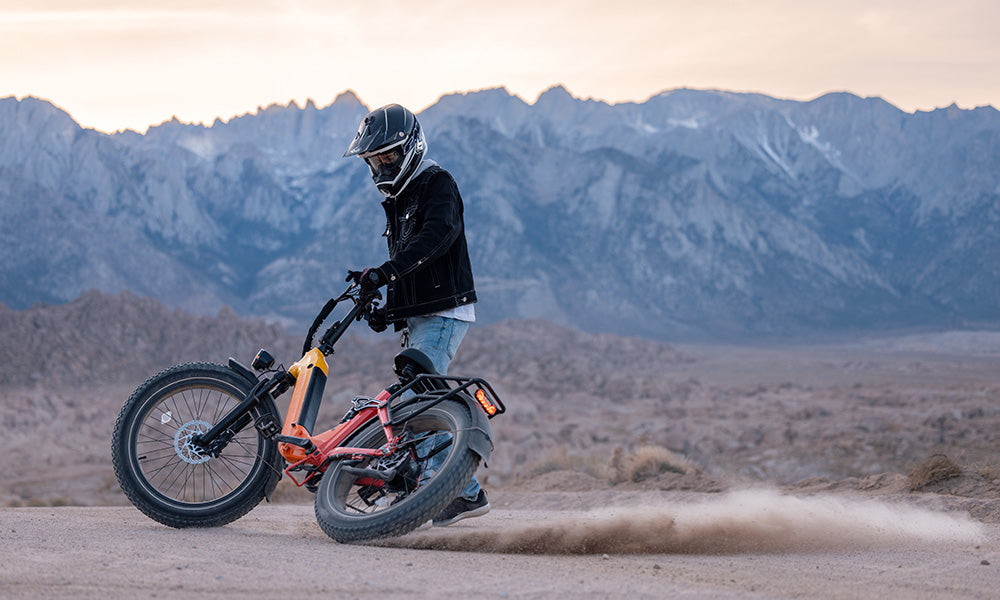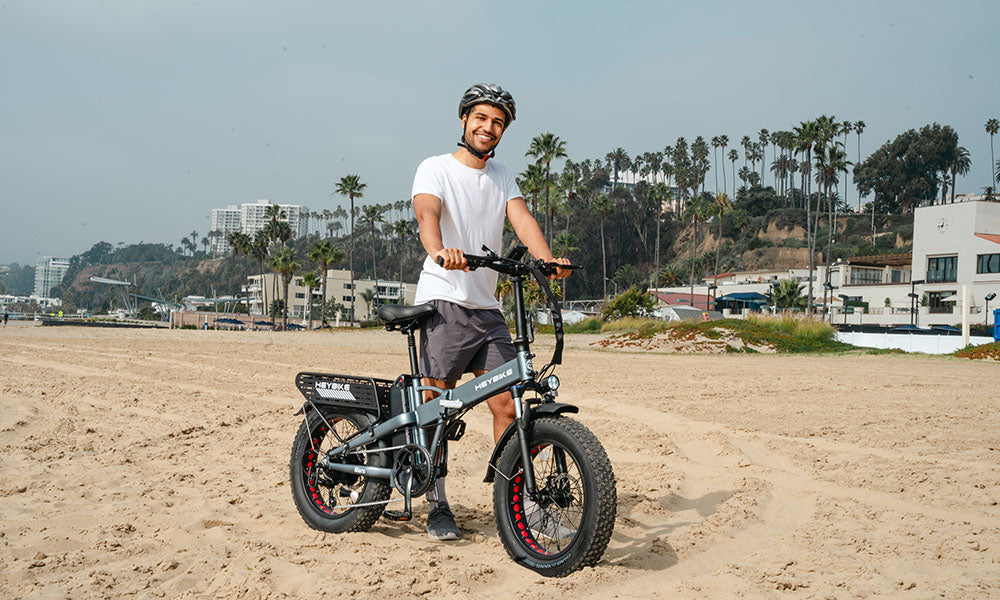The first modern fat tire bike was developed by French cyclist Jean Naud in 1986, where he rode a three-wheeled bicycle 3,200km across the Sahara Desert from Algiers to Timbuktu .
Widely considered a novelty until the 2000s, fat tire bikes have become a popular choice for riders wanting to tackle heavy-duty off-road conditions including sand and snow. With the addition of fat tire e-bikes, several big-name manufacturers offer a variety of wide tire bikes to choose from.
In this article, we discuss what a fat tire bike is good for and cover its pros and cons.
What is a Fat Tire Bike?

A fat tire bike is a bicycle with tires ranging between 3.5 to 5 inches in width and between 24 to 26 inches in diameter.
Both front and rear tires have a deep tread pattern designed to cut through terrain like snow and sand, providing traction and stability. The wide tires also allow you to have lower tire pressure, which makes it easy for you to ride over bumps and cushion the impact of landing after jumps.
Since fat tire bikes are designed for off-road use, they are often equipped with hydraulic front fork suspension to provide additional impact support.
What is a Fat Tire Bike Good for?
A fat tire bicycle is good for riding on terrain that may be unsafe or unsuitable for a commuter bicycle. The reason is that fat tire bikes are good at navigating complex terrain such as mud, snow, and sand. Fat tire bikes are also recommended for tackling highly technical routes, such as ascending and descending steep hills, riding over lots of debris, and navigating routes with lots of tight twists and turns.
Below are other recommended applications for wide-tire bikes:
Off-road Cycling
Fat tire bikes are excellent at maintaining traction and stability on mud, snow, loose gravel, and sand. They are also ideal for riding up and down steep hills as well as over bumpy, unpredictable terrain.
Snow Cycling

Thanks to the large diameter and wide tire profile, fat tire bikes can support the soft, cushiony texture of snow. So, if the idea of gliding across white powder appeals to you, then look no further than big tires for bikes.
There are a few considerations when riding in the snow. Climbing up steep hills in the snow can be brutal, leaving you hot and sweaty. As opposed to rugging up in heavy jackets, wear multiple layers of lightweight and breathable clothing. You may also want to buy a pair of winter cycle goggles to protect your eyes.
Rain Cycling
While it is possible to ride in the rain on a commuter bike, the journey is safer on a fat tire bike. That’s because the deep tread, along with the increased width and size of the tires, enable the bike to cut through the wet terrain and maintain grip.
The deep tread also helps prevent aquaplaning, which occurs when a tire is unable to push through standing water. The result is a loss or reduction in friction, increasing the risk of losing control and slipping.
Beach Cruising

While you won’t break any speed records on the beach, fat tire bikes are perfectly suited for riding on sandy beaches.
The ideal conditions for riding on the beach are flat and dry, as this terrain will require the least amount of effort to ride across. That being said, wide tire bikes are also capable of riding across damp sand; just be ready for a real workout.
Camping
If you enjoy camping in the great outdoors, then a fat tire bike will enable you to tackle the mountain, reach the highest points, and admire the spectacular views from above. Depending on the type of bike you purchase, you may also be able to attach a carry basket and use it to transport your camping supplies.
Bikepacking
Bikepacking is the combined practice of cycling and backpacking. It is typically a multi-day expedition, where you travel long distances and carry large amounts of supplies both on your person and your bicycle.
For these reasons, wide tire bikes are an excellent choice for bikepacking. You not only enjoy the benefits of the durable tires but also high carrying capacity, enabling you to transport all the supplies you need to survive – and thrive – during the trip.
Commuting
Fat tire bikes are not often used in urban environments – but that doesn’t mean you can’t. Do you need a bike for both daily commutes and the occasional off-road adventure? If so, a fat tire bike is versatile enough to satisfy your needs.
While you may not match the acceleration and top speed of a commuter bike, a fat tire bike will still get you from A to B comfortably. You can even enhance the performance with an electric motor. Use the manual throttle and pedal assist mode to accelerate with ease and reach a higher maximum speed.
All-round bike
For the longest time, the idea of a fat tire bike was a novelty. But those days are long gone. Today, wide tire bikes are acceptable for both everyday use and special applications, such as off-road riding.
A typical fat tire e-bike is equipped with an electric motor and rechargeable battery, a Shimano 7-speed gear system, hydraulic disc brakes, hydraulic front suspension, and a step-through or high-step frame.
Hunting

Due to their rugged frame and wide tire profile, fat tire bicycles are ideal for hunting. They enable you to navigate tricky terrain, carry an assortment of supplies (up to 330 lbs for some bikes), and traverse the land while making minimal noise.
Fat tire bikes also come in a variety of colors and designs, so you can blend in with your surroundings more easily. If you’re shopping for an electric fat tire bike, consider one with a high-capacity battery. For reference, the Heybike Horizon has a 864Wh battery that will take you about 65 miles on a single charge.
Pros of a Fat Tire Bike
Fat tire bikes have come a long way since the 1980s. And they’re more popular than ever! Research has shown that you can burn up to 1,000 calories per hour riding a wide tire bicycle, so they’re great for staying in shape.
But these pointers are just the tip of the iceberg. Here are other reasons why people are being swept up in the fat tire revolution.
1. Improved Traction
Wider tires cover a larger surface area than skinnier tires. Since there is more tire touching the surface, staying in control while riding over tricky terrain and turning corners is easier. The result? Improved traction and control.
2. Increased Stability
Aside from providing more traction, wide tires and low tire pressure also provide even weight distribution. This gives you better balance and control, meaning you’re less likely to tip to one side and fall over.
3. Enhanced Comfort
Comfort is everything when riding a bicycle. The same can be said for fat tire bikes, too. By having wider tires and lower tire pressure, fat tire bikes can more easily ride over objects and absorb the impact of jumps. As a result, even when handling the toughest terrain, you’ll feel as if you’re floating on a cloud.
4. Greater Cersatility
There is a reason why fat tire bikes have their origins in the desert; they enable you to go places other bikes cannot. This sentiment has remained true for nearly 40 years. When you have big tires for bikes, you can ride rougher than a commuter bike. Whether it be sand, dirt, or snow, when you go wide – there are more opportunities to ride.
5. Increased Load Capacity
Most fat tire bikes are fitted with highly durable frames, along with a fender and rear rack. This means you can attach a carry basket to your wide tire bicycles. So you can transport your belongings and camping supplies wherever you go.
Cons of Fat Tire Bikes
You really cannot go wrong with a fat tire bike. But there are a few pointers to consider if you plan on getting one. Being aware of these limitations will help you decide if a fat tire bike is right for you.
1. Heavy Weight
Due to the increased wheel size and width, fat tire bikes are often heavier than commuter bikes. Extra sturdy frames may also increase the weight.
2. Reduced Speed
Since fat tires occupy a larger surface area than skinnier tires, they produce more friction. The result is reduced acceleration and a slower top speed than a commuter bike. However, the versatility of a fat tire bike remains unmatched.
3. Higher Cost
Fat tire bikes often cost more than a standard commuter bike. This makes sense, as the tires are larger and more hard-wearing. So they need to be made of the highest quality components to tackle the toughest terrain.
Are Fat Tire Bikes Good for Heavy Riders?
Weight is an important factor when shopping for a fat tire bike. Some people may be concerned that their weight may limit their ability to ride a bike.
Fortunately, weight is rarely a hurdle to bike riding. Bike riding is an excellent form of exercise. Even if weight loss is not the goal, bike riding helps get your heart and blood pumping and strengthens your large muscle groups.
So, to answer the question, “Are fat tire bikes good for heavy riders?” The answer is a resounding yes. Just be sure to choose a frame style that suits your body type and to regularly maintain your tires and suspension. Otherwise, happy riding!
Are Fat Tire Bikes Fast?
Typically, fat tire bikes are not as fast as commuter bikes. Since the tires are wider and larger, the tires cover a larger surface area and make more contact with the ground. The result is more traction.
Of course, you can overcome the speed limitations of a fat tire bike with an electric motor. Take the Brawn electric bike for example. The peak 1400w electric motor has about 80 Nm of torque and a maximum top speed of 28 mph.
That’s a lot of power for a wide tire bicycle, and there are plenty of other models that offer similar performance.
Final Thoughts
Fat tire bikes provide outstanding durability and versatility in a wide range of conditions. But they are also suitable for use in urban environments and daily commuting. So, if you need a daily rider but also love going off-road, then big tires for bikes offer you the best of both worlds.


Share:
The Ultimate Guide to Electric Bikes for Camping
Hero Live on Indiegogo: The Powerful Carbon Fiber E-Bike Ever